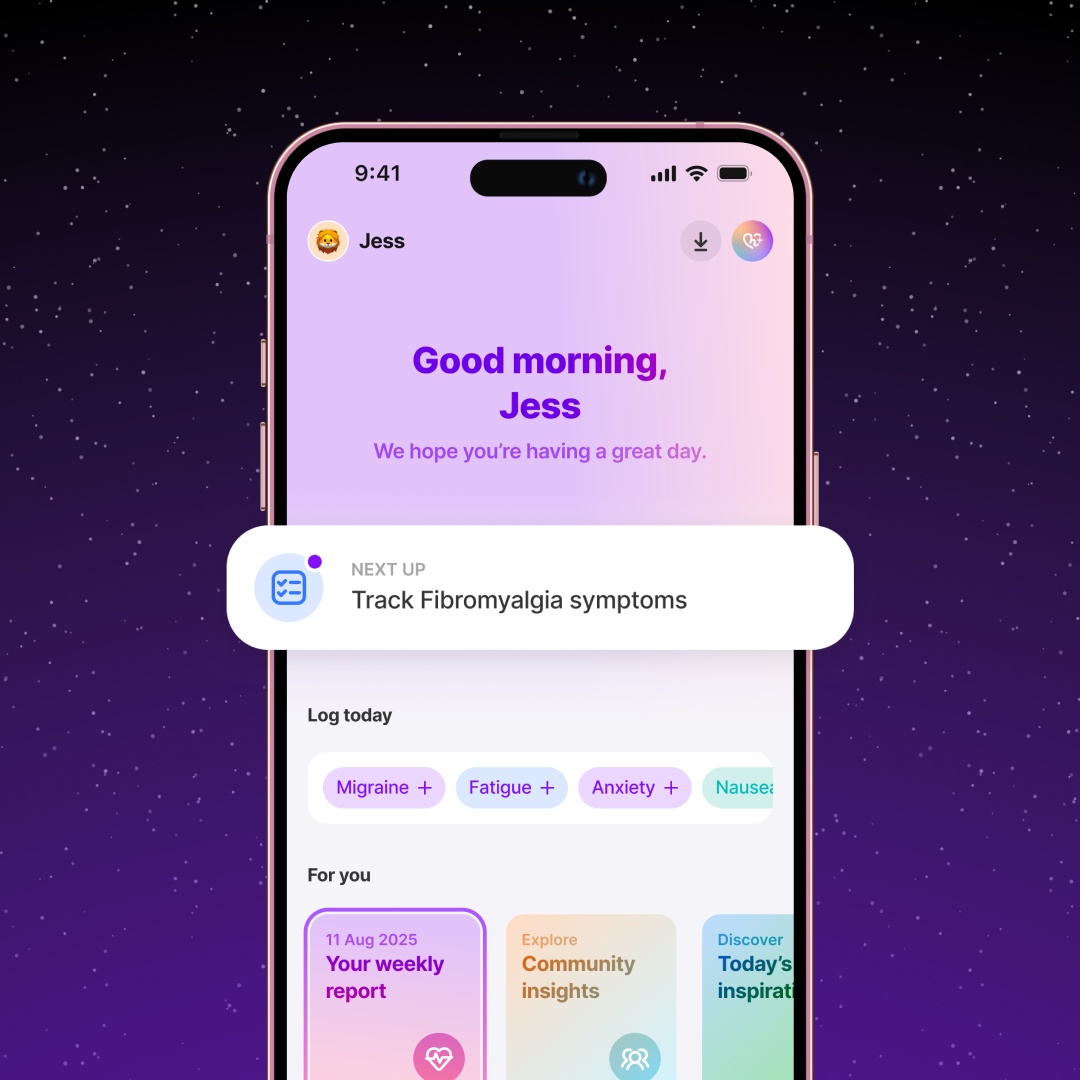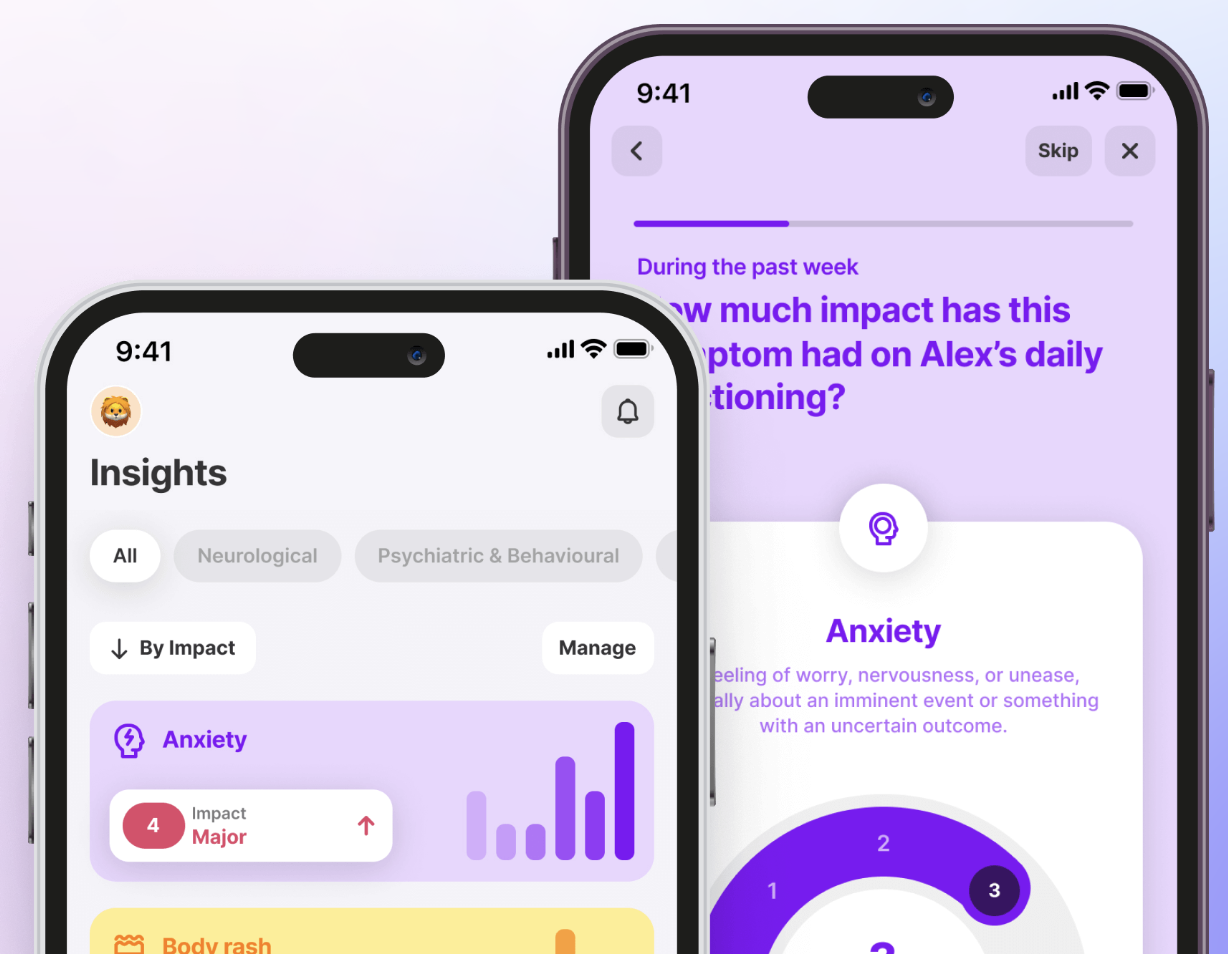Fibromyalgia Nausea: Possible Causes & How to Manage It
October 1, 2025

- Fibromyalgia and nausea are linked: Many people with fibromyalgia experience nausea, which can be triggered by pain flare-ups, poor sleep, or sensitivity to medications.
- Multiple factors may contribute: Digestive changes, nervous system imbalances, and overlapping conditions like irritable bowel syndrome (IBS) can all play a role.
- Nausea often comes with other symptoms: Fatigue, headaches, dizziness, or digestive discomfort may appear alongside nausea, making daily life more challenging.
- Tracking helps spot patterns: Using the Human Health app to log nausea, triggers, and routines can reveal patterns over time and support better discussions with your doctor.
Disclaimer: This article is for informational purposes only. It isn’t medical advice, diagnosis, or treatment. Always talk to a qualified healthcare provider about your health questions.
Living with fibromyalgia is already exhausting, and when nausea joins the picture it can make each day even harder. That sudden wave of queasiness can leave you struggling to eat, rest, or carry on with daily routines. For some, it comes and goes with flare-ups. For others, it lingers and becomes one more frustrating symptom to manage.
This article looks at why nausea happens in fibromyalgia, the symptoms it often comes with, and the possible causes behind it.
You’ll also find practical tips on managing it and see how using the Human Health app to track patterns can make your conversations with your doctor more focused and productive.
Understanding the link between fibromyalgia and nausea
Fibromyalgia is a condition in which the brain and nervous system process pain and sensory signals abnormally, often resulting in hypersensitivity to pain and other inputs. This overactive response may also contribute to digestive upset in some patients.
While researchers are still studying the exact connection, many people living with fibromyalgia report nausea (often with other gastrointestinal symptoms) — for example, one study found 34% of fibromyalgia patients in Brazil reported nausea/vomiting.
Interestingly, emerging studies have also explored potential overlaps between fibromyalgia and autism, as both conditions may share underlying neurological sensitivities and altered sensory processing patterns.
You can learn more about the connection between Fibromyalgia and Neuropathy here,
Similarly, researchers have noted connections between osteoarthritis and fibromyalgia, as both can involve chronic pain mechanisms and overlapping symptoms that affect quality of life.
For some, nausea may appear as a stand-alone symptom. For others, it’s closely tied to fatigue, headaches, or gastrointestinal discomfort. Tracking when and how nausea occurs can help reveal whether it’s directly linked to fibromyalgia flares or influenced by other factors in daily life.

Possible causes of fibromyalgia nausea
Nausea in fibromyalgia doesn’t usually have a single cause. Instead, it may arise from a combination of factors, making it challenging to pinpoint. Understanding the most common contributors is a good first step toward finding ways to ease the discomfort.
Nervous system imbalance
Fibromyalgia involves changes in how the central nervous system processes signals, often amplifying pain and sensory input. This heightened sensitivity may also affect the digestive system, creating nausea even without food triggers or illness. In other words, the body can “misread” signals from the gut and cause queasiness that feels unexplained.
Digestive disorders and IBS
Digestive issues such as irritable bowel syndrome (IBS) are common in people with fibromyalgia, often involving symptoms like bloating, abdominal pain, and irregular bowel habits. These digestive disturbances may contribute to episodes of nausea. Because these conditions overlap, it’s sometimes difficult to separate which symptoms stem from fibromyalgia itself and which are digestive in nature.
Medication side effects
Some treatments often used in fibromyalgia (such as antidepressants) list nausea among their reported side effects. While these medicines may ease pain or improve sleep, they can also cause stomach upset. This overlap can make it hard to tell whether nausea is part of the condition or linked to a medication.
Sleep disruption and fatigue
Poor sleep or sleep disturbances are a hallmark of fibromyalgia, and for many people, symptoms such as nausea tend to appear among the constellation of other worsening symptoms during periods of poor rest. This heightened response can leave people more prone to queasiness during or after a flare-up.
Because these causes often overlap, it can be hard to know what is driving nausea on any given day. Tracking when symptoms appear, and what else is happening at the same time, can help reveal which of these factors matter most for you.

Other possible symptoms that may accompany nausea in fibromyalgia
Nausea rarely shows up on its own in fibromyalgia. More often, it comes bundled with other symptoms that make daily life even more challenging. Knowing the common combinations can help you spot patterns that may otherwise be missed.
Fatigue and dizziness
Persistent tiredness and dizziness are among the most frequently reported symptoms of fibromyalgia. A 2022 study in the Journal of Clinical Medicine found that many people with fibromyalgia experienced chronic fatigue and vestibular symptoms such as dizziness and imbalance, which were often linked to overall symptom severity. When nausea occurs alongside fatigue or dizziness, it may contribute to a greater sense of exhaustion or instability, making daily tasks more challenging.
Headaches and migraines
Headaches and migraines are also common among people with fibromyalgia. A 2018 study in the Journal of Headache and Pain found that migraine episodes tend to be more intense and disabling when fibromyalgia is also present. Because nausea frequently occurs during migraine attacks, some individuals may experience these symptoms together, disrupting concentration and daily routines.
Digestive discomfort
Digestive issues such as bloating, cramping, or irregular bowel movements are frequently reported in fibromyalgia, often linked to irritable bowel syndrome (IBS). A systematic review published in the National Library of Medicine highlights that IBS and fibromyalgia commonly co-occur, with shared biological mechanisms involving the gut–brain axis and altered nervous system sensitivity. These overlaps may help explain why digestive discomfort and nausea often appear together for some people.
When nausea overlaps with these symptoms, the combined effect can feel overwhelming. Recording how they interact may help you and your provider understand not just the nausea itself, but the bigger picture of your condition.
{{inline-cta-1}}
Advice on how to manage Fibromyalgia-related nausea
Managing nausea with fibromyalgia usually takes a mix of approaches rather than one solution. Small changes to daily habits, stress relief, and consistent tracking can add up to make a real difference over time.
Lifestyle changes
Making small adjustments to eating and daily routines can make nausea more manageable. Some people with fibromyalgia report that dietary changes, such as choosing meal patterns that reduce gastrointestinal burden, may help lessen stomach discomfort. Staying hydrated throughout the day is equally important. Avoiding caffeine, greasy or fried foods, and strong odors may help reduce nausea and improve overall comfort.
Tracking symptoms & patterns
Keeping track of when nausea arises and what else is happening at the time can provide valuable insight. With the Human Health app, you can log symptoms, medications, and mood. Over time, these records can reveal patterns that support more focused conversations with your doctor.
Stress management techniques
Stress often makes fibromyalgia symptoms worse, and nausea is no exception. Incorporating stress-relief practices (such as deep breathing, meditation, or gentle yoga) can calm the nervous system and reduce overall symptom flare intensity, which for some people includes less nausea.
Adjusting daily routines
Living with fibromyalgia means finding balance. Sticking to a consistent sleep schedule, planning regular rest breaks, and pacing physical activity can keep energy more stable. These adjustments may not remove nausea entirely, but they often make it less overwhelming and easier to manage alongside other symptoms.
What works will vary from person to person, but the goal is the same: making nausea less disruptive and giving you more control. The more you notice your own patterns, the easier it becomes to find strategies that fit your life.
When to consult with a doctor about your nausea
While occasional nausea can be part of fibromyalgia, it’s important to talk with a healthcare provider if symptoms become frequent, severe, or disruptive to daily life.
Bringing clear notes to your appointment can make a big difference. Exportable symptom logs from the Human Health app help show when nausea happens, what else was going on at the time, and how long episodes lasted. This detail can speed up diagnosis and give your doctor a clearer view of your health patterns.
If you’re noticing that fibromyalgia symptoms such as nausea, fatigue, or pain are affecting your daily routines, you can take the fibromyalgia FIQR quiz to reflect on your current experiences and prepare for a more informed discussion with your healthcare provider.
Track symptoms, triggers, & patterns with the Human Health app
Nausea may not get as much attention as pain or fatigue in fibromyalgia, but for many people it is one of the most disruptive symptoms. It can make eating stressful, add to exhaustion, and take away from activities you enjoy.
While there is no quick fix, small changes, stress management, and careful tracking can all help reduce its impact.
The Human Health app gives you an easier way to stay on top of these patterns. By logging nausea alongside moods and medications, you can create clear reports to share with your provider. Over time, these insights may help you understand your body better and support a care plan that fits your needs.
Log your symptoms in Human Health now to uncover patterns and give your provider the insights that matter most.
Frequently Asked Questions:
How long do nausea episodes typically last in fibromyalgia?
The duration varies. Some people feel queasy for minutes, while others experience nausea that lingers for hours during flare-ups.
Could tracking nausea patterns help reduce its impact?
Yes. By logging symptoms, triggers, and routines in the Human Health app, you and your provider may uncover ways to lessen nausea over time.
Disclaimer: Human Health is a health tracking platform and does not provide medical advice, diagnosis, or treatment. The information on this site is intended to support, not replace, conversations with qualified healthcare professionals.
References
- MDPI: Fibromyalgia: Understanding, Diagnosis and Modern Approaches to Treatment
- Reumatología Clínica: High frequency of gastrointestinal complaints, but insignificant prevalence of gluten-sensitive enteropathies in Brazilian fibromyalgia patients
- Frontiers in Medicine: Fibromyalgia and Associated Disorders: From Pain to Chronic Suffering, From Subjective Hypersensitivity to Hypersensitivity Syndrome
- National Library of Medicine: A systematic review of the association between fibromyalgia and functional gastrointestinal disorders
- National Library of Medicine: Adverse Effects of Antidepressants for Chronic Pain: A Systematic Review and Meta-analysis
- National Library of Medicine: Fibromyalgia Syndrome: An Overview of Pathophysiology, Diagnosis and Management
- National Library of Medicine: Fibromyalgia in migraine: a retrospective cohort study
- National Library of Medicine: Vestibular Disability/Handicap in Fibromyalgia: A Questionnaire Study
- National Library of Medicine: Fibromyalgia and Irritable Bowel Syndrome Interaction: A Possible Role for Gut Microbiota and Gut-Brain Axis
- National Library of Medicine: Nutritional Interventions in the Management of Fibromyalgia Syndrome
- National Library of Medicine: Mindfulness Meditation for Fibromyalgia: Mechanistic and Clinical Considerations
- ScienceDirect: Treating fibromyalgia with mindfulness-based stress reduction: Results from a 3-armed randomized controlled trial
- Stanford Hospital & Clinics: Nutrition Tips for Nausea and Vomiting
This is a div block with a Webflow interaction that will be triggered when the heading is in the view.


Manage Your Health Condition With the Human Health App
With the Human Health app, you can track your symptoms, flares, changes & more. Our app is your personal health diary. Try it today, for free.








.jpg)




.png)

